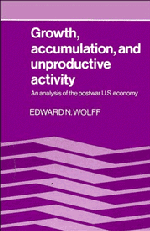Book contents
- Frontmatter
- Contents
- Preface
- 1 Introduction
- 2 Unproductive activity in a capitalist society
- 3 A Marxian accounting framework
- 4 A growth model of accumulation and unproductive labor
- 5 Rise of unproductive activity in postwar economy
- 6 Absorption of labor and capital and rate of surplus value
- 7 Absorption of new resources and growth in real income
- 8 Conclusions and speculations
- Appendix: Data sources and methods
- References
- Index
4 - A growth model of accumulation and unproductive labor
Published online by Cambridge University Press: 24 March 2010
- Frontmatter
- Contents
- Preface
- 1 Introduction
- 2 Unproductive activity in a capitalist society
- 3 A Marxian accounting framework
- 4 A growth model of accumulation and unproductive labor
- 5 Rise of unproductive activity in postwar economy
- 6 Absorption of labor and capital and rate of surplus value
- 7 Absorption of new resources and growth in real income
- 8 Conclusions and speculations
- Appendix: Data sources and methods
- References
- Index
Summary
These points may seem carping or conjectural, but they are not without tangible effects. A nation's values and problems are mirrored in the ways in which it uses its ablest people. In Japan, a country only half our size, 30 percent more engineers graduate each year than in all the United States. But Japan boasts a total of less than 15,000 lawyers, while American universities graduate 35,000 every year. It would be hard to claim that these differences have no practical consequences. As the Japanese put it, “Engineers make the pie grow larger; lawyers only decide how to carve it up.” …
In law, the actors have different names but the plot is much the same. Legal staffs of large corporations have become the most rapidly growing segment of the bar. At the same time, private law firms continue to expand by opening branches in more and more cities. For clients at the lower end of the economic spectrum, larger forms of organization are likewise developing: prepaid group plans, companies offering cut-rate legal services in supermarkets and shopping malls, poverty law offices funded by the federal government.
These new organizations will have effects on what we pay for legal work in this country. To a degree, they may help to lower attorneys' fees by engendering greater competition and economies of scale. Nevertheless, the total bill for legal services in America does not depend nearly so much on the size of attorneys' fees as it does on the volume of litigation and legal services throughout the society [emphasis added]. […]
- Type
- Chapter
- Information
- Growth, Accumulation, and Unproductive ActivityAn Analysis of the Postwar US Economy, pp. 86 - 103Publisher: Cambridge University PressPrint publication year: 1986



